Imagine looking at a blank document, the cursor blinking on the page, and the stress of creating amazing content is building. We have all been there. The writer’s block. The stress of creating helpful content day in and day out can be very draining. But what if I said you can now get a secret weapon, a writing partner to assist you past these challenges and boost your productivity? AI automatic writing will change the world of writing as we know it.
What is AI Automatic Writing?

AI automatic writing is the use of artificial intelligence to generate written content. It provides a tireless assistant capable of producing articles, blog posts, social media updates, and even creative stories with minimal human input. This cutting-edge technology leverages sophisticated algorithms, which are fueled by vast amounts of data, to understand and mimic human language patterns, grammar, and style. But it’s more than just mimicking; AI writing tools learn and adapt to become more effective and nuanced with each use.
Comprehensive Review of Leading AI Writing Applications
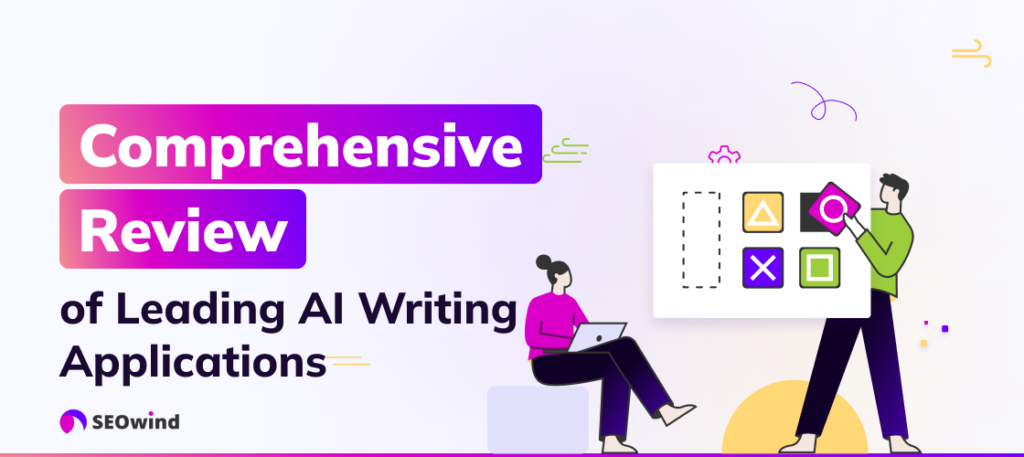
Today, the demand for high-quality written material has skyrocketed. As a result, businesses and individuals are constantly seeking innovative solutions to streamline their content creation process. This is where the remarkable capabilities of AI automatic writing come into play.
The emergence of sophisticated software has revolutionized how we approach content creation.
Here, we’ll cover some of the leading AI writing applications that are transforming the writing game. Whether you’re an experienced writer seeking a productivity boost or a novice looking for guidance, there’s an AI writing tool out there tailored to your needs.
Analyzing the Top Tools
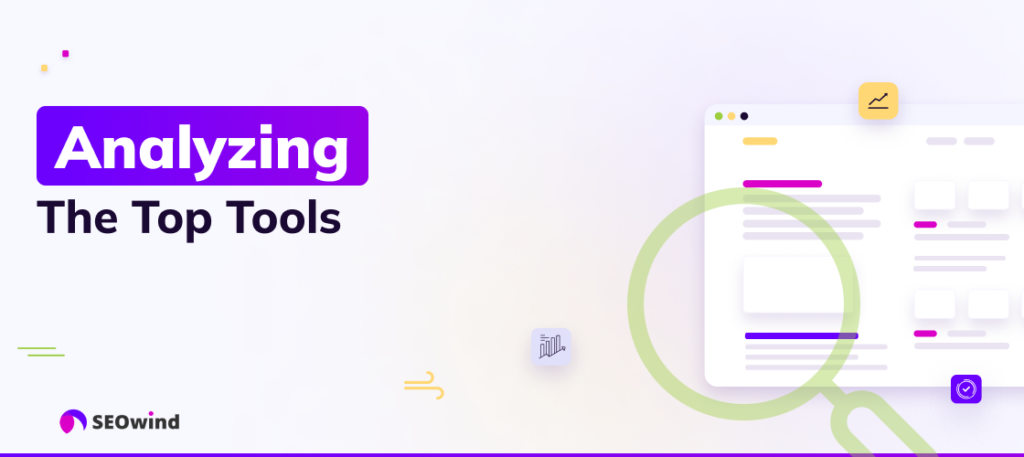
Navigating AI writing tools can feel like stepping into a jungle: dense, exciting, and overwhelming. Fortunately, I’m here to guide you through the thick of it. Let’s break down some of the top contenders in this by examining their strengths, limitations, and ideal use cases.
SEOwind: research, write, enrich
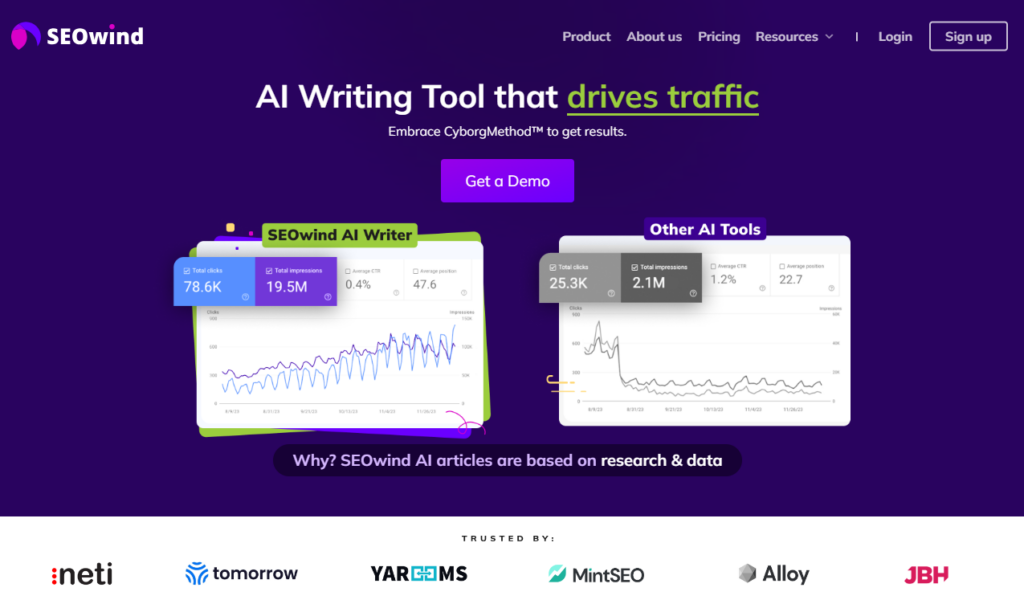
SEOwind is like that Swiss Army Knife you have tucked away: versatile, dependable, and surprisingly sharp. It is your SEO specialist, data researcher, content writer and proofreader in AI writing tool.
- All-in-One Platform: Research, outlining, writing, and optimization capabilities all in one place.
- SEO Powerhouse: As its name suggests, SEOwind excels at crafting SEO-friendly content. It performs keyword analysis, competitor analysis, and content optimization when writing.
- Long-Form Content: SEOwind shines when it comes to crafting long-form content like blog posts and articles.
- AI-Powered Writing Modes: SEOwind lets you choose from the most popular AI models to get the content writing style you need.
SEOwind Key Features:
- SEO Missions – conduct a keyword gap analysis to choose the keywords that will bring you traffic, conversions, and revenue,
- Content and keyword research to collect SERP and SEO data in one place,
- AI outline and brief – draft your outline based on data and research,
- Feed AI with context – provide AI with stats and quotes, internal links and custom insights,
- Write AI article that rank.
Weaknesses:
- Pricing: While there’s discounted access to SEOwind, $7 for 7 days to test the waters, unlocking SEOwind’s full potential requires a subscription.
Use Cases:
- Content Creators: SEOwind is a boon for bloggers, marketers, and anyone looking to create high-quality, SEO-optimized content consistently.
- Businesses: Drive traffic and revenue to your website through engaging and high-quality articles.
- Agencies: Streamline the content creation process while keeping high-quality content briefs and articles.
Jasper
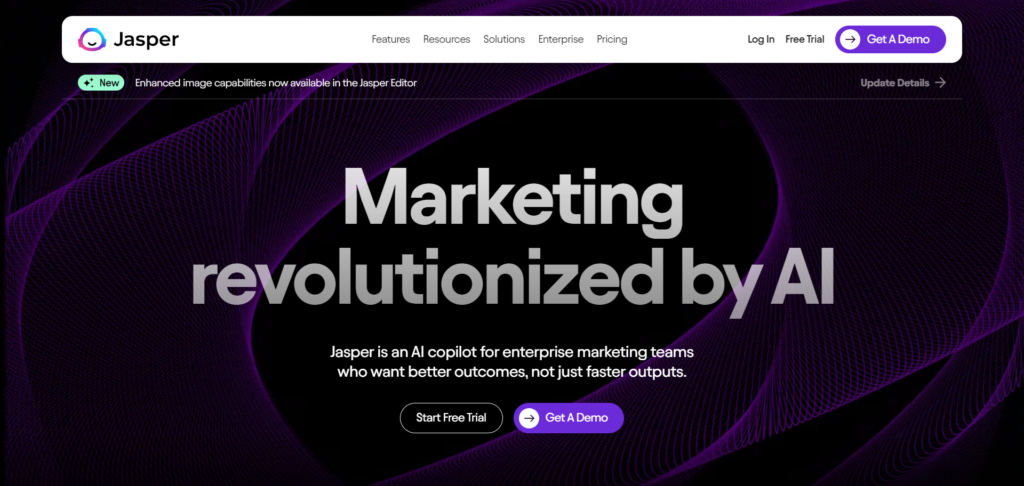
If SEOwind is a Swiss Army Knife, Jasper is a seasoned wordsmith: eloquent, creative, and bursting with ideas.
Key Features:
- “Boss Mode” for Enhanced Control: This feature gives you granular control over the output, allowing you to fine-tune the AI’s suggestions.
- Collaboration Tools: Jasper is an excellent option for teams and offers features that streamline collaboration on writing projects.
Weaknesses:
- SEO Features Could Be Stronger: While Jasper can generate creative content, its SEO capabilities aren’t as robust as some competitors.
- Pricing Tiers: Jasper’s subscription plans can get pricey, especially if you need access to its advanced features.
Use Cases:
- Bloggers and Writers: Jasper can be a potent solution for overcoming writer’s block and regularly producing high-quality content.
- Marketers: Do you need to create compelling ad copy, social media posts, or product descriptions? Jasper can handle it all with flair.
Copy.ai
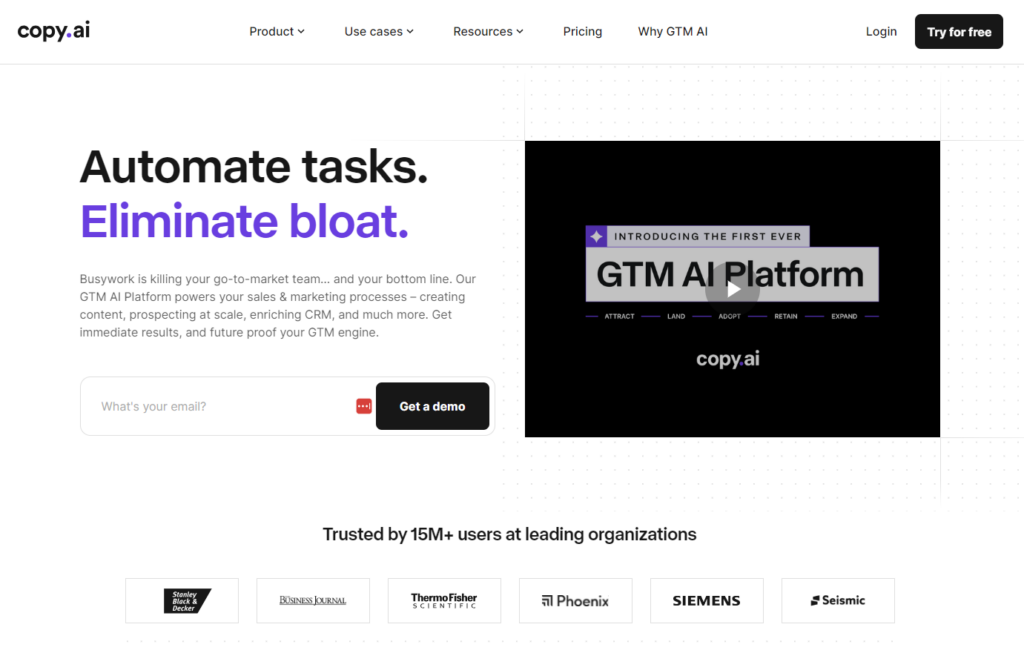
Think of Copy.ai as a quick and agile copywriter. It’s ideal for short-form content that packs a punch.
Key Features:
- Short-Form Content Specialist: Copy.ai excels at generating attention-grabbing headlines, social media posts, ad copy, and other short-form content.
- Ease of Use: Copy.ai boasts an intuitive interface that makes it incredibly user-friendly, even for beginners.
- Variety of Templates: Looking for inspiration? Copy.ai offers a vast library of templates for various content types and purposes.
Weaknesses:
- Limitations with Long-Form Content: Copy.ai’s strength is generating short-form content; there are better choices for crafting long articles or blog posts.
- Creative Output Can Be Hit or Miss: While Copy.ai can generate some real gems, there are times when the output might require some editing.
Use Cases:
- Social Media Managers: Keep your social media feeds buzzing with engaging content using Copy.ai’s quick and easy content generation.
- Marketers: If you’re focused on creating compelling text for ads or catchy taglines, Copy.ai can help you craft attention-grabbing content that converts.
Writesonic
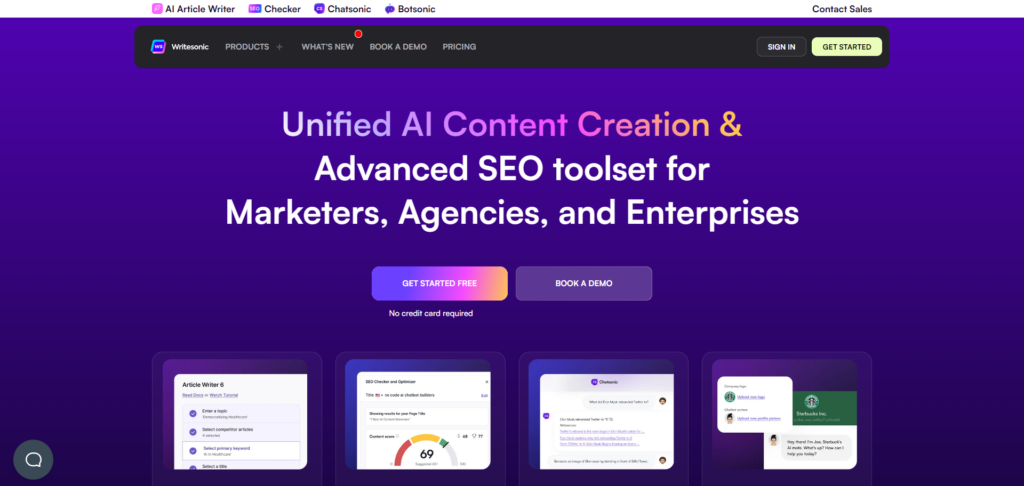
Writesonic is a reliable workhorse that is always ready to tackle your writing tasks, no matter how big or small.
Key Features:
- Balance of Features: Writesonic offers a good balance of features for both short-form and long-form content creation.
- SEO Optimization Tools: Improve your content’s visibility with Writesonic’s built-in SEO analysis and optimization features.
- Affordable Pricing: Writesonic offers competitive pricing plans, making it a budget-friendly option for individuals and businesses.
Weaknesses:
- Can Feel Generic at Times: While Writesonic consistently produces decent content, it might lack the creative spark of some competitors.
- Limited Collaboration Features: If you work in a team, Writesonic’s collaboration tools might be somewhat limited.
Use Cases:
- Bloggers and Content Creators: Writesonic can help you maintain a consistent content calendar by generating high-quality articles and blog posts.
- Marketers: From email campaigns to website copy, Writesonic can assist in creating various marketing materials.
Anyword
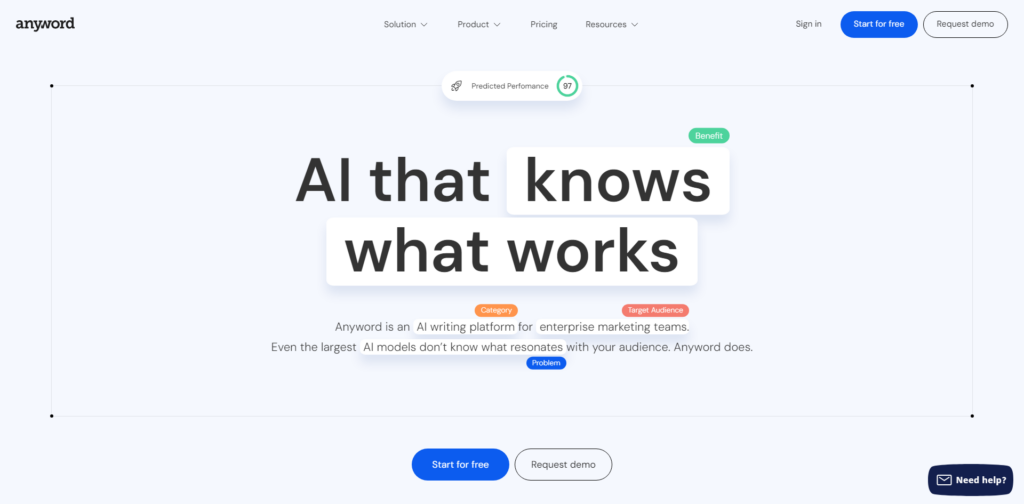
If you’re looking for an AI writing tool that doubles as a data-driven marketing guru, then Anyword might be a match made in tech heaven.
Key Features:
- Data-Driven Approach: Anyword leverages data and analytics to predict content performance and guide your writing to achieve higher engagement.
- Focus on Marketing Material: While Anyword offers versatility, its true strength is crafting high-conversion marketing assets.
- A/B Testing Capabilities: Anyword allows you to test different versions of your copy to see what resonates best with your target audience.
Weaknesses:
- Less Versatile for Non-Marketing Content: Anyword’s focus on marketing might make it less suitable for creative writing or non-marketing content needs.
- Pricing Can Be a Barrier: Anyword’s pricing might be prohibitive for individuals or small businesses on a tight budget.
Use Cases:
- Marketers and Advertisers: Anyword’s data-driven approach can help optimize your marketing copy to achieve maximum impact.
- Businesses Looking to Improve Conversion Rates: If you’re serious about boosting your conversion rates, Anyword’s A/B testing and data-driven insights can be invaluable.
Evaluating Use-Cases: From Marketing Copy to Fiction Writing
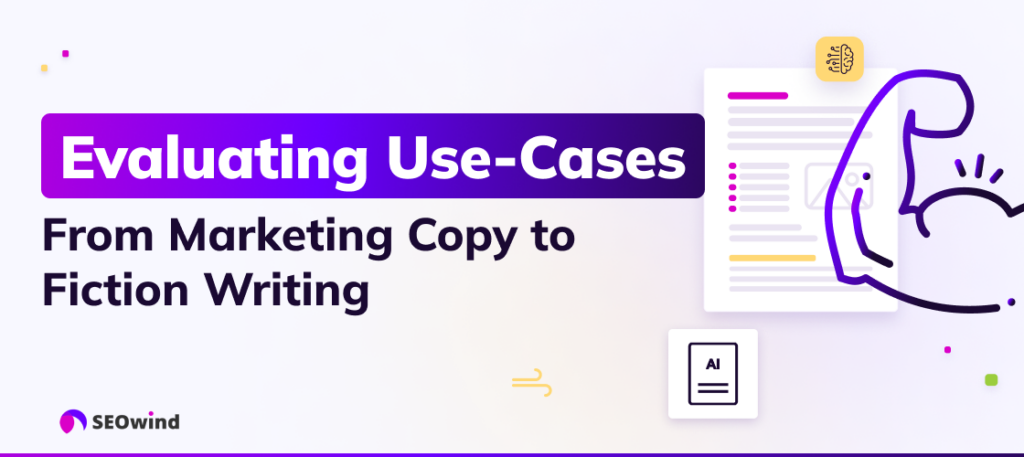
The beauty of AI automatic writing is its versatility. It’s like having a multi-tool in your writing toolkit, ready to tackle anything from a catchy tagline to a captivating novel. Let’s explore how this technology is transforming various writing tasks:
- Marketing and Advertising: This is where AI truly shines. Whether you need persuasive ad copy that converts, engaging website content, or compelling social media posts, AI marketing generators can handle it all. They can even analyze data to tailor your message to specific audiences.
- Content Creation: Whether it’s blog posts, articles, or even video scripts, AI writing tools can help you consistently produce high-quality content. If you’re struggling with writer’s block, AI can provide creative prompts and even generate different drafts for you to choose from.
- Business Writing: From emails and reports to presentations and proposals, AI can help you communicate more effectively in a professional setting. It can ensure your writing is clear, concise, and error-free. This frees up your time to focus on the strategic aspects of your work.
- Creative Writing: Yes, AI is even making its mark in fiction. While it can’t replace the human touch entirely, it can be a valuable tool for authors. Think of an AI creative writing generator as a brainstorming partner that helps you overcome writer’s block or explore new narrative possibilities. It can suggest plot twists, develop characters, and even generate different writing styles.
- Improving Existing Content: Have a piece of writing that needs polishing? AI writing software can help you refine your work. They identify grammar errors, suggest better word choices, and even improve the overall clarity and flow of your writing. With these solutions, you’ll always have an AI writing assistant there to provide valuable feedback and suggestions.
Specialized Tools for GPT-4 Content and Beyond
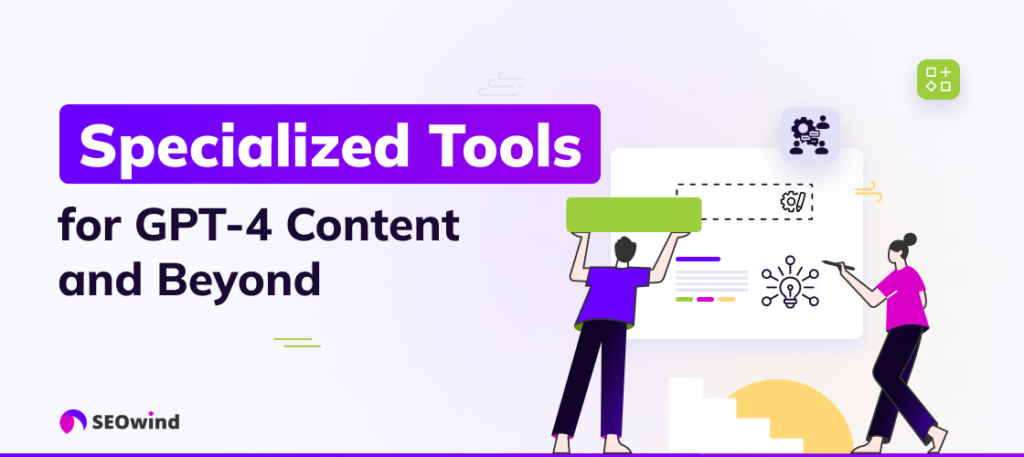
The landscape of AI writing tools is constantly evolving. Exciting new players are emerging, particularly those designed to harness the capabilities of advanced models like GPT-4. These specialized tools go beyond basic content generation to offer features tailored for specific writing tasks and advanced customization. They are engineered to understand complex instructions, making them ideal for tasks demanding a high degree of accuracy and nuance. In addition, these tools can analyze data, translate languages, and even mimic different writing styles, pushing the boundaries of what’s possible with AI-powered writing tools.
But how do you go about choosing the best tool for your business? Some platforms provide templates specifically optimized for GPT-4, while others offer seamless integration with its API. Regardless of your chosen tool, remember that crafting effective prompts is the key to unlocking its full potential.
AI prompt text generators help you formulate clear and concise instructions that guide the AI in generating the desired output. The more specific and detailed your prompt, the more impressive the results. Essentially, you’re collaborating with the AI, providing the framework for it to work its magic.
As you explore GPT-4-powered tools, you’ll discover many possibilities. From crafting engaging social media posts to generating comprehensive reports, these advanced platforms transform how we approach content creation. By embracing the power of these cutting-edge tools, you can unlock new levels of productivity and creativity in your writing.
Advantages of Using AI for Writing Tasks

While writing was once considered an exclusively human domain, it is now being reshaped by the innovative capabilities of AI. This powerful technology is rapidly changing how we approach content creation, offering a spectrum of benefits that boost efficiency, spark creativity, and optimize resource allocation. Let’s take a look at how these AI writing tools can transform your writing process.
Increasing Efficiency and Productivity in Content Creation
AI writing tools excel at generating different types of text quickly and efficiently. Whether you need a catchy introduction, a well-structured outline, or even a complete blog post draft, these tools significantly reduce the time and effort required for content creation. This allows you to focus on refining your ideas, adding your unique voice, and connecting with your audience.
Take, for instance, the task of drafting social media posts. Instead of spending hours brainstorming and writing, an AI writer assistant can generate a week’s worth of engaging posts in minutes, complete with relevant hashtags and a consistent brand voice.
Enhancing Creativity Through Automated Suggestions
Many writers fear that using AI will stifle their creativity. However, an AI writing tool can act as your creative partner, pushing the boundaries of your imagination and helping you overcome writer’s block. By providing alternative phrasing, suggesting relevant topics, and even generating different writing styles, these tools can help you discover new perspectives and unlock creative avenues you might have otherwise overlooked.
Imagine writing a short story and finding yourself stuck on a particular plot point. With its access to vast amounts of text data, an AI writing tool can suggest various scenarios, character motivations, or unexpected events, effectively helping you overcome the creative hurdle and explore uncharted narrative territories.
Cost Reduction Strategies for High-Quality Content Production
In a competitive digital landscape, consistently producing high-quality content is paramount. However, hiring professional writers or allocating extensive resources for content creation can strain budgets. AI writing tools offer a compelling solution by streamlining the process and reducing costs without compromising quality. This makes them a valuable asset for businesses, bloggers, and content creators of all sizes.
This McKinsey report (No link) highlights the potential of generative AI, suggesting it could reduce the volume of human-serviced contacts by up to 50 percent. This translates to significant cost savings, allowing businesses to allocate their resources more effectively and achieve a higher return on investment. Whether you’re a small business owner seeking to maximize your marketing budget or a large corporation aiming to streamline content production, AI writing tools provide a cost-effective pathway to achieving your content goals.
Potential Downsides and Considerations
While AI writing tools offer a powerful solution for content creation, it’s essential to approach their use with a balanced perspective. Like any technology, AI writing comes with potential downsides and ethical questions.
Addressing Concerns Over Originality and Authenticity
One of the primary concerns connected to AI-generated content is the potential for plagiarism. While AI writing tools strive to produce original content, unintentional plagiarism can occur.
It’s crucial to remember that these tools learn from massive datasets of existing text and code. As a result, there’s a risk that the output generated may inadvertently echo phrases, sentences, or even entire paragraphs from the training data.
To mitigate this risk and ensure originality, always run the AI-generated content through a reliable plagiarism checker before publishing or submitting it. In addition, don’t rely solely on AI output. Instead, use it as a foundation and add your unique insights, analysis, and personal experiences.
Navigating Ethical Implications
Beyond plagiarism, using AI for writing raises broader ethical questions about authorship, transparency, and the potential impact on human creativity.
For example, who can claim authorship if a piece of writing is primarily generated by an AI? The user who inputted the prompts? The developers of the AI tool? Or the AI itself?
Transparency is also a top priority. If you’re using AI to assist with your writing, it’s generally considered a good ethical practice to disclose this to your audience. This transparency lets readers make informed judgments about the content’s creation process.
Maintaining a Human Touch in AI-Assisted Writing
Finally, we need to recognize that while AI can mimic human-like writing, it often lacks the genuine emotion, empathy, and nuanced understanding that characterizes exceptional content.
Over-reliance on AI-generated content could lead to a homogenization of writing styles and a decline in the diversity of voices and perspectives. To avoid this:
- Use AI to enhance your writing, not replace it entirely.
- Prioritize developing your own unique writing voice and style.
- Focus on infusing your content with your personality, experiences, and perspectives.
Remember, AI should complement and augment your writing process, not overshadow or diminish your unique voice and creativity.
Google’s Guidelines and SEO Best Practices for AI-Generated Content
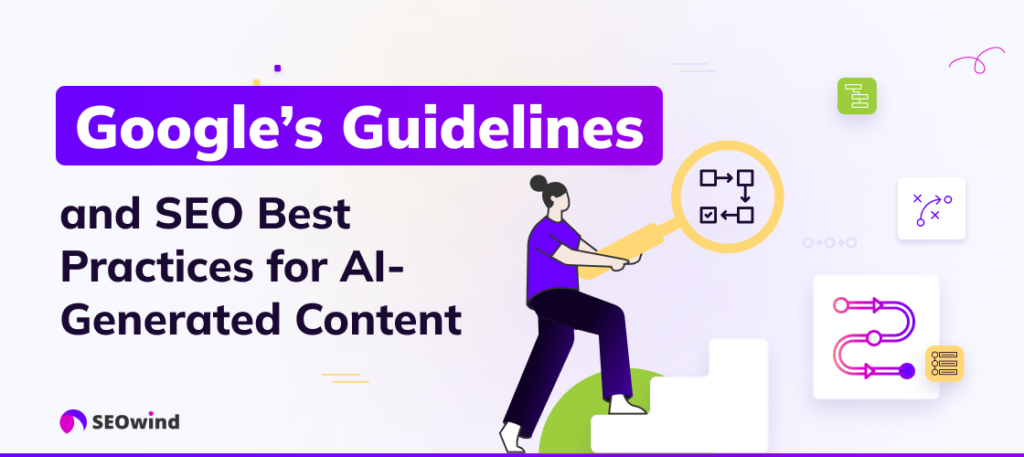
Google’s guidelines emphasize creating people-first content, whether crafted by human hands or with the assistance of AI. The search engine focuses on quality, originality, and value for readers. But what does this mean in the age of AI content creation?
Focusing on Experience, Expertise, Authoritativeness, and Trustworthiness (E-E-A-T)
E-E-A-T has become a cornerstone of Google’s evaluation process, and for good reason. When users search for information, they want to be confident that the content they’re reading comes from a credible source. As such, understanding and incorporating E-E-A-T is essential, especially when using tools like an AI SEO generator or blog writing software.
With that in mind, let’s cover each point of E-E-A-T:
- Experience: Has the author demonstrated real-world experience in the subject matter? A blog post about baking bread is more trustworthy if the author is an experienced baker. This doesn’t mean you need to be a world-renowned expert, but demonstrating some level of experience is necessary.
- Expertise: Expertise goes hand-in-hand with experience. You should showcase your deep knowledge and understanding of a topic. This can be achieved by providing accurate information, citing credible sources, and using industry-specific language.
- Authoritativeness: Authoritativeness is about establishing yourself or your brand as a trusted source of information. This can be built through testimonials, industry recognition, or consistently producing high-quality content. If you’re using an AI website copy generator, ensure the content aligns with your brand’s voice and expertise.
- Trustworthiness: Building trust with your audience is crucial. This involves being transparent about your use of AI, backing up claims with evidence, and ensuring your content is factually accurate.
Adhering to these principles ensures that your content resonates with Google and your target audience. The goal is to establish yourself as a reliable source of information within your niche.
Practical Tips for Optimizing Results with AI Writing Tools
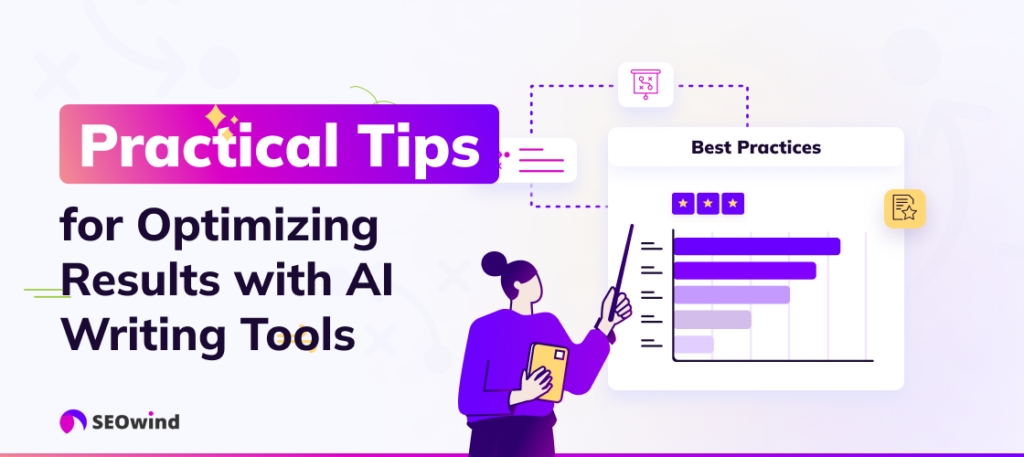
Using AI writing tools effectively is about more than just plugging in a few keywords and expecting a masterpiece. To unlock AI’s power and elevate your writing, you need to understand how to use these tools strategically.
Mastering Prompts to Generate Desired Outcomes
Crafting effective prompts is one of the most crucial aspects of using AI writing tools. A prompt provides the tool with instructions that tell it what you want it to write about and how. It’s the difference between saying, “Write something about coffee” and “Write a 100-word blog post about the history of coffee in Italy, focusing on the role of espresso.”
The more specific and detailed your prompt, the better the AI can understand your needs and generate content that aligns with your vision. Think about these factors when crafting your prompts:
- Context: What is the overall topic and purpose of your writing?
- Target Audience: Who are you writing this for? What is their reading level and background knowledge?
- Desired Tone and Style: Do you want it to be formal or informal, humorous or serious?
- Keywords: Are there any specific keywords or phrases you want to include?
- Length and Format: What is the desired length and format of the output?
Experiment with different phrasing and levels of detail to see what generates the best results. Don’t hesitate to iterate and refine your prompts until you achieve the desired output. Clear and concise instructions are key to getting the AI to produce exactly what you need.
Leveraging Rephrasing and Editing Features
Even with the most meticulously crafted prompts, AI-generated content requires a human touch to shine. This is where rephrasing and editing features help you out. They provide a trusty toolkit for polishing and refining the tool’s output, ensuring that it meets your standards for originality and quality.
Many AI writing tools come equipped with built-in rephrasing capabilities. These features can be handy for:
- Enhancing Clarity and Flow: Rephrasing tools can help you simplify complex sentences, improve sentence structure, and create a smoother reading experience.
- Adding Variety and Interest: Don’t be afraid to experiment with different synonyms and sentence structures to break up repetitive phrasing and keep your writing fresh.
- Ensuring Originality: While AI writing tools are designed to generate original content, it’s always wise to double-check for any unintentional plagiarism. Rephrasing tools can be invaluable for ensuring that your writing is entirely your own.
AI writing tools are designed to be your partners in content creation, not replacements for your unique voice and perspective. Embrace the collaborative aspect of these tools, and don’t hesitate to edit and refine the AI’s output to align with your vision.
Understanding How AI Writing Tools Function
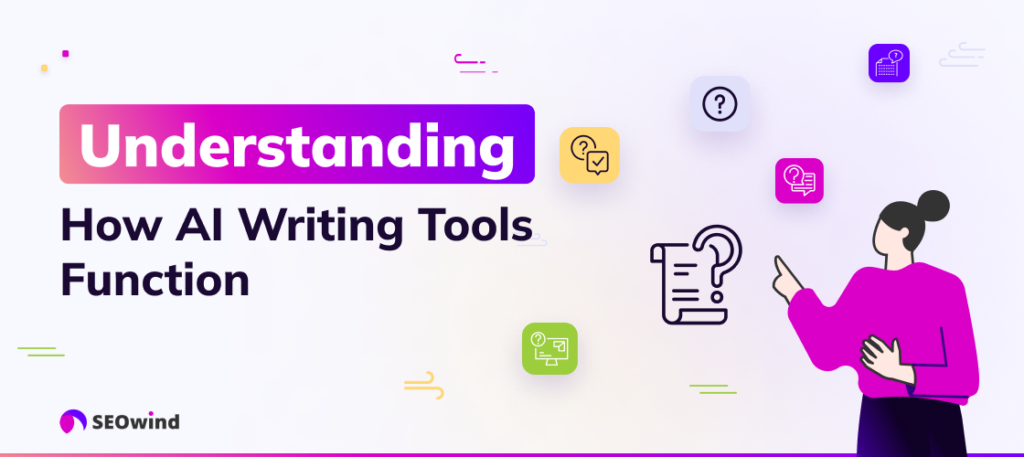
The information below might interest you if you’re interested in how AI writing tools work.
Basic Principles Behind AI-Generated Content
At their core, AI writing tools are sophisticated algorithms trained on massive text datasets. These datasets are the foundation for their understanding of language structure, grammar, and writing styles. When you feed a prompt into an AI prompt writer, it doesn’t magically conjure up text. Instead, it leverages its training to predict the most probable next word in a sequence based on the input you’ve provided. This process is repeated, word by word, sentence by sentence, to generate coherent and contextually relevant text.
Key Technologies Powering AI Writing: NLP and Machine Learning
Two key technologies enable the functionality of AI writing tools: Natural Language Processing (NLP) and Machine Learning (ML). NLP acts as the bridge between human language and computer understanding. It allows AI to interpret your prompts, decipher the nuances of language, and generate text that aligns with your instructions. On the other hand, ML is the engine that drives the learning process. Through algorithms and statistical models, ML empowers AI to identify patterns in data, learn from them, and continuously improve its content generation capabilities.
The Role of User Input and Customization
While the technology behind AI writing tools is impressive, it’s crucial to remember that user input plays a pivotal role in shaping the output. An AI prompt writer thrives on clear, specific instructions. The more context you provide in your prompts, the better the AI can understand your requirements and generate content that meets your expectations. Furthermore, most AI-powered writing tools offer various customization options, allowing you to fine-tune the output to match your desired style, tone, and format. Whether you need a conversational blog post or a formal email, customizing the parameters can significantly enhance the relevance and quality of the AI-generated content.
FAQ
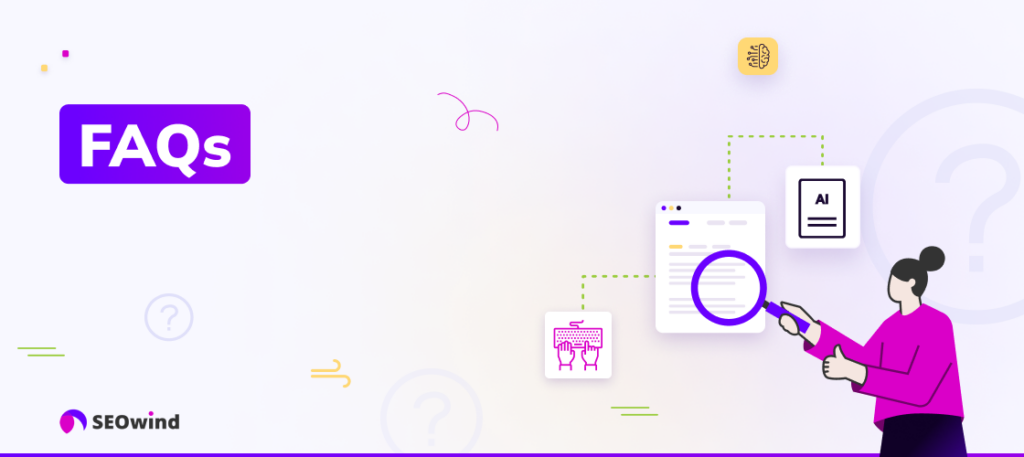
Is there an AI that can write text?
Absolutely! You’ve probably encountered AI-generated text without realizing it. AI writing tools are popping up everywhere. These tools can generate anything from social media posts to full-blown articles. If you need text, there’s likely an AI out there that can help you create it. Some tools even offer a free AI content writer option, which is a great way to dip your toes into the water. If you’re searching for an AI writing site, you’ll find numerous options, each boasting unique features. But remember, not all AI solutions are created equal.
What AI tool do you recommend for writing a blog post? (SEOwind)
If you’re looking for an AI companion to help you craft compelling blog posts, I highly recommend checking out SEOwind. It’s more than just an AI tool; SEOwind is a comprehensive platform that assists you throughout the entire writing process. From keyword research and content generation to optimization and beyond, SEOwind is designed to streamline your content creation journey.


